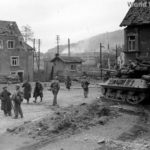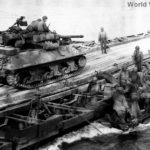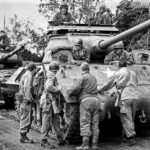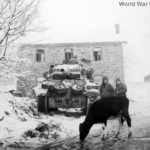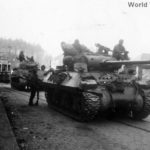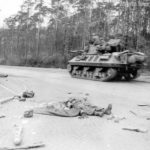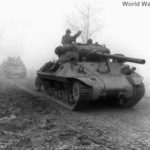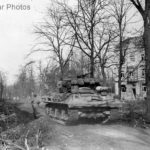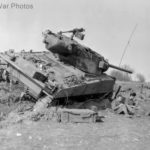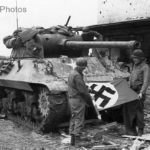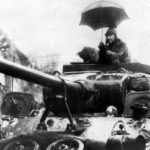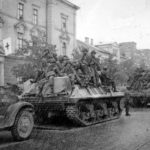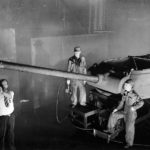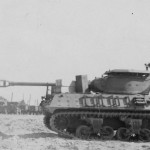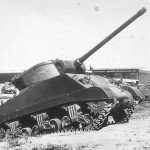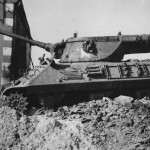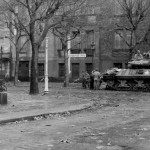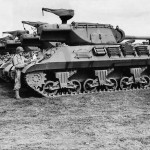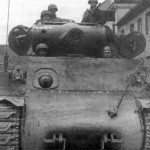M36 and M4 of the 3rd Armored Division, Houffalize, Belgium, Battle of the Bulge, January 1945
Troops from 45th ID with group of liberated Russian slave laborers in Niederwurzbach, 23 March 1945
M36 crosses Rhine on engineer bridge 24 March 1945
A column of M36 tank destroyers
2nd Armored Division M36 in Lipperode, Germany 2 April 1945
8th Infantry Division halted inside the ruins of Duren during Operation Grenade 23 February 1945
M36 in the Ardennes, 1945
M36 and M4 of the 102nd ID, 771st Tank Destroyer Battalion, Krefeld March 3, 1945
M36 1945
M36 in Metz 19 November 1944
Column of M36 and M4 Belgium October 1944
M36 of the 347th Infantry Regiment in Plauen, 1945
M36 Germany 1945
M36 move forward along a road
M36 of the 703rd Tank Destroyer Battalion Werbomont, 20 December 1944
M36 in Julich, Germany 24 February 1945
M36 of the 9th Armored Division, Spring 1945
Knocked out 90 mm Gun Motor Carriage M36B1, 1945
M36 destroyer crew with a German swastika flag
9th Army soldier under umbrella atop M36 Jackson – Germany 1945
M36 and 3rd Division troops move to the front in hailstorm at Augsburg, Germany April 1945
M36 Jackson of the Third Army, January 1945 Luxembourg
M36 Jackson tank destroyer coming off the assembly line at the Grand Blac Michigan tank plant of the Fisher Body Division of General Motors 1944
90 mm Gun Motor Carriage M36 Jackson
M36 Slugger Tank Destroyer Tested at Aberdeen 1945
M36 35th Infantry Division 654th Tank Destroyer Battalion in Oberbrauch Germany 1945
M36 Jackson Tank Destroyer 1944
M36 Jackson Ardennes Offensive
M36 Jackson and Maginot Line Pillbox 776th Tank Destroyer Battalion Hottviller France 1944
M36 Jackson in the streets of Metz November 21 1944
Line of M36 Tank Destroyers at Repair Depot in France 1944
M36B1 ank destroyer 1945
M36 of the 702nd Tank Destroyer Battalion
The 90 mm Gun Motor Carriage, M36, was an American tank destroyer used during World War II. The M36 was essentially an up-gunned M10 tank destroyer, replacing the former’s indifferent 76 mm gun with a powerful 90 mm gun. The advent of larger, better armoured German tanks with 88mm guns led to US studies into a more powerful tank destroyer. One of the pilot models of the M10 was tested with a 90mm anti-aircraft gun in mid-1942 and, although it fitted, balance problems were exacerbated. There was also a lack of space to carry the large shells, so a new turret was designed, with work beginning in early 1943. The new unit had power traverse and a revised layout so that the gunner sat on the right side and the loader on the left. The turret had rounded sides, rather than the lozenge shape of the M10. A contract to convert M10A1 s on the production line was given in November 1943 and the new vehicle, which had the test designation of T71, became the M36 GMC in June 1944.
A shortage of M10A1 chassis available for conversion led to the M36B1, which was simply the new turret on the hull of an M4A3. The M36B1 retained the hull machine gun and had much better armour protection. The M36B2 was created from M10 hulls when all available MIOAls had been used up, and had folding armoured sheets as standard to cover the top of the hull when necessary.
About 2,324 of all models were constructed or converted. M36s started to arrive in France in September 1944 and sported the best AFV-mounted US gun on the battlefield at that time. Capable of firing M71 HE, T33 APC-T, T30E16 (M304) HVAP-T or smoke ammunition, the 90mm (3.54in) gun had a muzzle velocity of l,02lm/sec (3,350ft/sec) with High Velocity Armour Piercing Tracer (HVAP-T) ammunition.
The M36 could defeat the armour of the Tiger and Panther without closing to point-blank range; its gun had a maximum range of 17,885m (19,560yd) firing HE. The M36 fought in Korea and was supplied to many nations under the post-war MAP programme. With the break-up of Yugoslavia, Croatian and Serbian forces acquired the Army’s M36s.
Technical specifications
crew | 5 |
lenght | 7465 mm |
hull lenght | 5970mm |
width | 3048 mm |
height | 3278 mm |
combat weight | 28580 kg |
weight | 26310 kg |
ground pressure | 0.917 kg/cm2 |
armor / angle: | hull: 38 – 50 – 108 mm front, 19 – 25,4 mm sides, 19 mm rear, 19,1 – 9,5 mm top, 12,7 mm bottom turret: sides : 31,8 mm, rear: 44,5 – 127 mm, top: 9,5 – 25,4 mm mantlet: 76,2 mm |
main armament | 90 mm M3 gun, 47 rounds. Elevation: -10° – +20°; |
secondary armament | 12,7 mm M2HB, 1000 rounds |
engine: | Ford GAA 6046, 331 kW at 2600 rpm, 8 cylinder, water-cooled, gasoline 7098 cm3. |
transmission | 5 forward and 1 reverse |
fuel | 846 l |
fuel consumption (road / off road) per 100 km | |
tracks | T48, T49, T51, T54E1 |
tracks width | 420,6 mm |
number of links per track | |
track contact | |
track base | 2108 mm |
max speed | 42 km/h |
range | 240 km |
grade | 60% |
turning radius | |
trench crossing | 2290 mm |
vertical obstacle | 610 mm |
fording | 900 mm |
ground clearance | 432 mm |
manufacturer | Fisher Tank Arsenal, Massey Harris Co. , ALCO, Montreal Locomotive Works |
Source:
Christopher F. Foss: The Encyclopedia of Tanks and Armored Fighting Vehicles: The Comprehensive Guide to over 900 Armored Fighting Vehicles from 1915 to the Present Day

